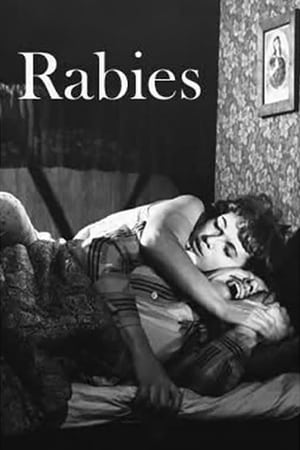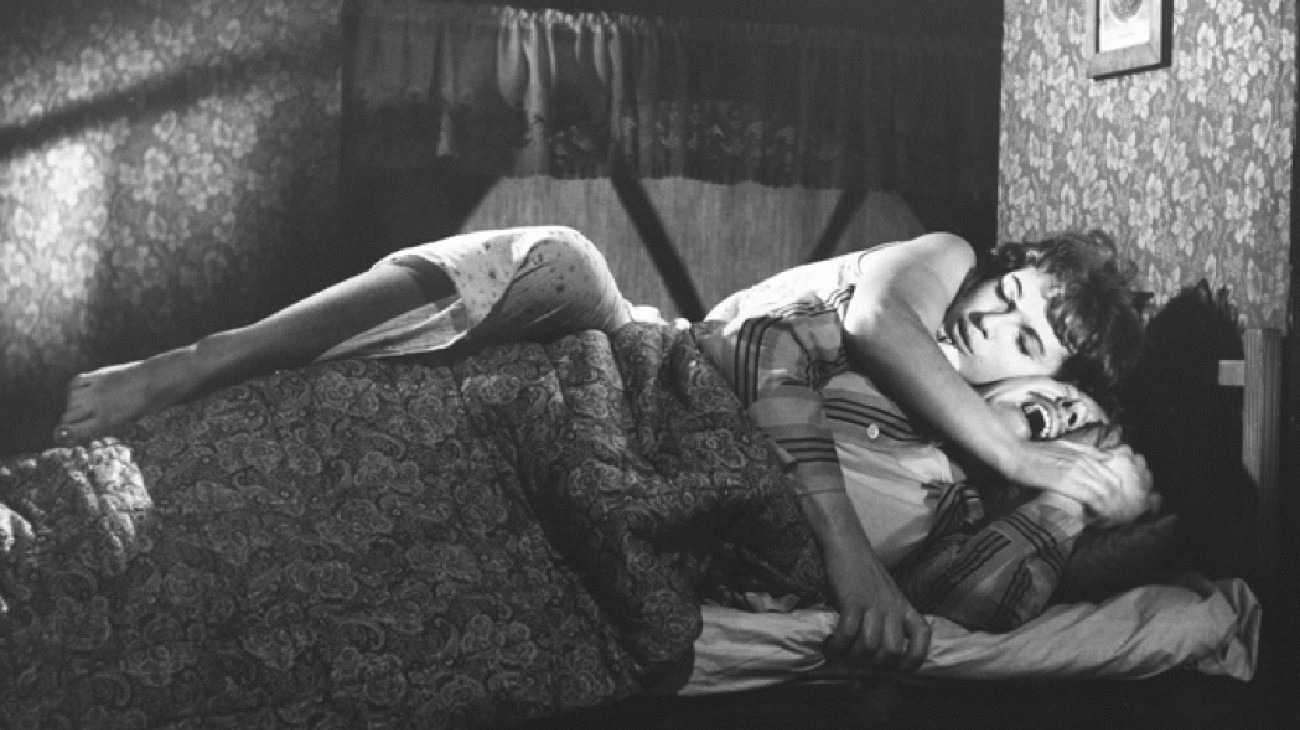
Ingmar Bergman's televised theater, part III
The phrase which most irresistibly attaches itself to Rabies, a 1958 television play that is maybe the most obscure piece of filmed media Ingmar Bergman ever directed, is "an unpleasant piece". Bergman himself first described it that way in 1945, in the notes to his production of the play onstage at the Helsingborg City Theatre; he meant this in a good way. Adapted by Olle Hedberg's from a cycle of chapters in his own novel Loafing, the play is all about the way that human cruelty feeds on itself, and Bergman's hope was that the production would aggressively and unapologetically confront the audience with all of the caustic truths of humanity in the miserable chaos of the post-war world. It has an admittedly terrific hook: in the first scene, one character acts needlessly vicious to another character, then in the second scene that character would vent their anger on a third character, and so on. It is precisely the structure of Arthur Schnitzler's play La Ronde, which was adapted into a gorgeous, much-celebrated film in 1950 by Max Ophuls. Only with way more naked bitterness and cynicism about the fundamental wickedness of human beings.
The play, in its original production, made quite a splash, and Bergman kept working with it, adapting it for radio in 1946 before stepping away from it for 12 years. The 1958 telefilm was his third go-round with the material, so we can guess if nothing else that he surely must have believed in it; I confess that I believe in it less than he did. "An unpleasant piece" is exactly right, but I don't see anything but unpleasantness. The idea of the thing, reflected in its title, is that human cruelty is basically a disease, spread virulently from every act of petty meanness by people who think of themselves as fundamentally weak and helpless to do anything but lash out at whoever crosses their path. I get why that might have had an extra charge in 1946, but it seems like nasty pessimism devoid of any insight, devoid of any sense of moral weight.
It's also a bit chilly and detached from itself, which is part of what makes it feel so uninsightful, I think. We arrive in the office of Dr. Bo Stenson Svenningsson (Max von Sydow), the protagonist of the original novel and our window into the play's game of human behavior. He tells us as much, staring right into the camera to explain what we're in for, using just exactly the clinical professionalism one would expect of a medical professional. This leaves things feeling a bit arch even before we get started with the first scene proper, and that archness is compounded by the attention-grabbing title cards and loud blast of generically urgent music that accompany them, as soon as the doctor is done talking. These cards will be repeated with every new relay from one arrangement of characters to the next, telling us who is involved and how much time has passed, and there's a certain brittle, tongue-in-cheek quality to these little inserts that serves even more to set us outside the film, and align us to the doctor who seems to be treating this all as an experiment in studying human behavior.
To its credit, Rabies at least doesn't feel like canned theater. It's a silly little thing to make a big deal about, but I would absolutely hate to undersell how much those inserted title cards feel like they define the film's tone, not least because they force an "outside" on it that would be harder to achieve in theater (and certainly couldn't be done at all in this exact fashion). It would of course be inappropriate and insane to compare this to the work of Jean-Luc Godard, a filmmaker whose career hadn't started, and whom Bergman would find pretentious and intolerable once it did. But there's a bit of Godardian post-modernism in the way that the title cards come as a rupture, not just to the structure of the story, but to the film's own aesthetic. It is a noisy shock every time it happens, somehow managing to diminish the impact of the relay gimmick by carving the movie into discrete units that all feel very isolated and separate, even as the cards theoretically call attention to the interrelationship of scenes.
So, my point is, the director is definitely not just sleepwalking through an adaptation of a play he knew quite well - he's reconceiving it as a cinematic object quite thoroughly, even as the scenes themselves feel like they exist in a black box theater, with their empty spaces and long takes. But whether or not Bergman was trying to make something potent and powerful with Rabies, I simply don't think he got there. If I complain the characters all seem to lack individual personalities, I mean this as no slight on the actors, including Bergman screen stalwarts Bibi Andersson, Åke Fridell, and Gunnel Lindblom (in an odd strategy, if strategy it was, the four actors most recognisable from Bergman's films are also the first four who show up in the movie, and those leave it fastest - the rest of the cast is made up of people he'd worked with at Malmö City Theatre). Everybody involved is doing what they can with what the play has given them. It's just that the play actively is working broadly with types, and channeling every character's action into such a narrow band of possibilities, basically giving every performer the same option: you're miserable, and it gives you dark pleasure to spread your misery around.
It's very direct, is Rabies, and as promised, very unpleasant. But it's limited: scene after scene of people being shitty in boring, petty ways, in empty grey spaces. There's no sense of anything bigger than just nasty-minded grubbing, and nothing to compensate for the feeling of being trapped in a box with several passive-aggressive assholes. It is, I concede, not surprising that Bergman of all directors was attracted to this material, but it's so little, and when Bergman-style miserabilism is made little, it also becomes kind of tedious, frankly.
The play, in its original production, made quite a splash, and Bergman kept working with it, adapting it for radio in 1946 before stepping away from it for 12 years. The 1958 telefilm was his third go-round with the material, so we can guess if nothing else that he surely must have believed in it; I confess that I believe in it less than he did. "An unpleasant piece" is exactly right, but I don't see anything but unpleasantness. The idea of the thing, reflected in its title, is that human cruelty is basically a disease, spread virulently from every act of petty meanness by people who think of themselves as fundamentally weak and helpless to do anything but lash out at whoever crosses their path. I get why that might have had an extra charge in 1946, but it seems like nasty pessimism devoid of any insight, devoid of any sense of moral weight.
It's also a bit chilly and detached from itself, which is part of what makes it feel so uninsightful, I think. We arrive in the office of Dr. Bo Stenson Svenningsson (Max von Sydow), the protagonist of the original novel and our window into the play's game of human behavior. He tells us as much, staring right into the camera to explain what we're in for, using just exactly the clinical professionalism one would expect of a medical professional. This leaves things feeling a bit arch even before we get started with the first scene proper, and that archness is compounded by the attention-grabbing title cards and loud blast of generically urgent music that accompany them, as soon as the doctor is done talking. These cards will be repeated with every new relay from one arrangement of characters to the next, telling us who is involved and how much time has passed, and there's a certain brittle, tongue-in-cheek quality to these little inserts that serves even more to set us outside the film, and align us to the doctor who seems to be treating this all as an experiment in studying human behavior.
To its credit, Rabies at least doesn't feel like canned theater. It's a silly little thing to make a big deal about, but I would absolutely hate to undersell how much those inserted title cards feel like they define the film's tone, not least because they force an "outside" on it that would be harder to achieve in theater (and certainly couldn't be done at all in this exact fashion). It would of course be inappropriate and insane to compare this to the work of Jean-Luc Godard, a filmmaker whose career hadn't started, and whom Bergman would find pretentious and intolerable once it did. But there's a bit of Godardian post-modernism in the way that the title cards come as a rupture, not just to the structure of the story, but to the film's own aesthetic. It is a noisy shock every time it happens, somehow managing to diminish the impact of the relay gimmick by carving the movie into discrete units that all feel very isolated and separate, even as the cards theoretically call attention to the interrelationship of scenes.
So, my point is, the director is definitely not just sleepwalking through an adaptation of a play he knew quite well - he's reconceiving it as a cinematic object quite thoroughly, even as the scenes themselves feel like they exist in a black box theater, with their empty spaces and long takes. But whether or not Bergman was trying to make something potent and powerful with Rabies, I simply don't think he got there. If I complain the characters all seem to lack individual personalities, I mean this as no slight on the actors, including Bergman screen stalwarts Bibi Andersson, Åke Fridell, and Gunnel Lindblom (in an odd strategy, if strategy it was, the four actors most recognisable from Bergman's films are also the first four who show up in the movie, and those leave it fastest - the rest of the cast is made up of people he'd worked with at Malmö City Theatre). Everybody involved is doing what they can with what the play has given them. It's just that the play actively is working broadly with types, and channeling every character's action into such a narrow band of possibilities, basically giving every performer the same option: you're miserable, and it gives you dark pleasure to spread your misery around.
It's very direct, is Rabies, and as promised, very unpleasant. But it's limited: scene after scene of people being shitty in boring, petty ways, in empty grey spaces. There's no sense of anything bigger than just nasty-minded grubbing, and nothing to compensate for the feeling of being trapped in a box with several passive-aggressive assholes. It is, I concede, not surprising that Bergman of all directors was attracted to this material, but it's so little, and when Bergman-style miserabilism is made little, it also becomes kind of tedious, frankly.






